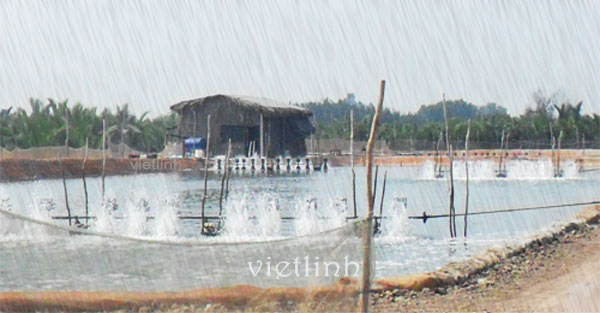Welcome to Viet Linh's aquaculture technology news today!
Our topic today is: Ways to reduce the cost of shrimp farming.
When the price of shrimp decreases while the price of feed, materials, electricity and labor increases, farmers need to carefully calculate and apply measures to reduce farming costs to preserve capital.
Reducing the cost of shrimp farming can be achieved through various strategies that focus on optimizing efficiency, improving production practices, and minimizing expenses. Here are some approaches to consider:
Site selection: Choose an appropriate location for your shrimp farm that offers favorable environmental conditions. Look for areas with access to clean water sources, suitable soil quality, and protection from extreme weather events to reduce the need for expensive infrastructure and maintenance.
Pond design and management: Optimize the design and layout of your shrimp ponds to maximize space utilization and minimize water and energy requirements. Implement proper water management techniques, such as efficient water circulation systems and recycling mechanisms, to reduce costs associated with water consumption and discharge.
Stocking density: Optimize stocking density to achieve a balance between maximizing production and minimizing stress-related issues. Overcrowding can lead to poor growth rates, increased disease susceptibility, and higher feed requirements. By maintaining appropriate stocking densities, you can improve growth efficiency and reduce costs.
Feeding management: Develop a well-balanced and cost-effective feeding strategy for your shrimp. Use high-quality feed that promotes growth and health while minimizing waste. Proper feeding practices, such as adjusting feeding rates based on shrimp size and monitoring feeding efficiency, can help reduce feed costs.
Change the way of feeding: Feed accounts for 50 to 60% of the cost of shrimp farming. Of which, about one-fifth of the feed is discharged into the environment, which is not used by the shrimp, polluting the water and pond bottom.
Therefore, according to Viet Linh, you can reduce the total amount of food in the day, down to 70-80% compared to the theoretical calculation formula, and not evenly divide food for meals but feed when more, when less according to the formula. following principles:
1. Feed shrimp more at times when shrimp eat a lot: early morning and evening.
2. Reduce the amount of food in the meals when shrimp eat less: at night, in the afternoon sun.
3. Reduce the amount of food when: shrimp molt, it is hot, it is raining and cold, there is a sudden change in the pond environment.
4. Create a natural food source for shrimp, especially when shrimp are young.
5. Using good quality feed to increase the health and growth of shrimp, limit pollution, and disease is also to reduce the cost of drugs and treatment chemicals.
Disease prevention: Implement robust biosecurity measures to prevent disease outbreaks in your shrimp farm. This includes regular monitoring, quarantine procedures for new shrimp stocks, and strict hygiene practices. By minimizing the risk of diseases, you can reduce the need for costly treatments and losses associated with disease outbreaks.
Change the way you use materials: Costs for drugs, microorganisms and chemicals usually account for 20 to 30% of the cost of shrimp farming. According to Viet Linh, you need to regularly check the water environment, and the health of shrimp to minimize treatment and treatment costs. The ways to do this are:
1. Early detection of signs of environmental pollution or disease of shrimp for early treatment.
2. Using drugs and supplies, chemicals at the right time, right type, right dose.
Efficient use of energy: Implement energy-saving practices in your shrimp farm, such as using energy-efficient equipment and optimizing energy consumption in aeration systems, pumps, and lighting. Additionally, consider utilizing renewable energy sources like solar power to reduce electricity costs.
Monitoring and data analysis: Regularly monitor key parameters such as water quality, feed conversion ratio, growth rates, and production performance. By collecting and analyzing data, you can identify areas for improvement and make informed decisions to optimize your farm operations, resulting in cost savings.
Collaboration and knowledge sharing: Engage with fellow shrimp farmers, industry experts, and research institutions to stay updated on the latest advancements in shrimp farming techniques, technologies, and best practices. Sharing knowledge and experiences can help you identify innovative cost-saving methods and strategies.
Economies of scale: Consider scaling up your operation if feasible. Expanding the farm size can lead to economies of scale, allowing you to reduce costs through bulk purchasing, improved infrastructure utilization, and enhanced operational efficiencies.
Financial management: Ensure efficient financial management practices by keeping detailed records of expenses, revenues, and production costs. Regularly review your financial statements to identify areas where costs can be reduced or optimized.
Remember, the cost reduction strategies may vary depending on the specific circumstances of your farm and the prevailing market conditions. It's essential to assess and adapt these strategies to suit your unique situation and seek advice from local aquaculture experts for guidance tailored to your region.
Thank you for listening to this news, Viet Linh wish you successful farming, lots of health and joy.
© Viet Linh 2023
